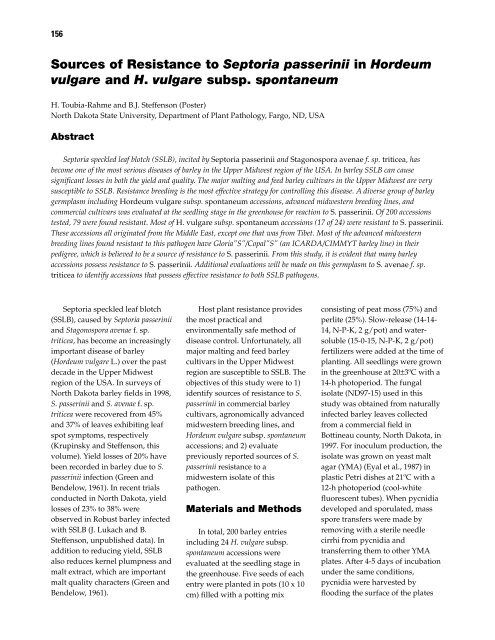Septoria and Stagonospora Diseases of Cereals - CIMMYT ...
Septoria and Stagonospora Diseases of Cereals - CIMMYT ...
Septoria and Stagonospora Diseases of Cereals - CIMMYT ...
You also want an ePaper? Increase the reach of your titles
YUMPU automatically turns print PDFs into web optimized ePapers that Google loves.
156<br />
Sources <strong>of</strong> Resistance to <strong>Septoria</strong> passerinii in Hordeum<br />
vulgare <strong>and</strong> H. vulgare subsp. spontaneum<br />
H. Toubia-Rahme <strong>and</strong> B.J. Steffenson (Poster)<br />
North Dakota State University, Department <strong>of</strong> Plant Pathology, Fargo, ND, USA<br />
Abstract<br />
<strong>Septoria</strong> speckled leaf blotch (SSLB), incited by <strong>Septoria</strong> passerinii <strong>and</strong> <strong>Stagonospora</strong> avenae f. sp. triticea, has<br />
become one <strong>of</strong> the most serious diseases <strong>of</strong> barley in the Upper Midwest region <strong>of</strong> the USA. In barley SSLB can cause<br />
significant losses in both the yield <strong>and</strong> quality. The major malting <strong>and</strong> feed barley cultivars in the Upper Midwest are very<br />
susceptible to SSLB. Resistance breeding is the most effective strategy for controlling this disease. A diverse group <strong>of</strong> barley<br />
germplasm including Hordeum vulgare subsp. spontaneum accessions, advanced midwestern breeding lines, <strong>and</strong><br />
commercial cultivars was evaluated at the seedling stage in the greenhouse for reaction to S. passerinii. Of 200 accessions<br />
tested, 79 were found resistant. Most <strong>of</strong> H. vulgare subsp. spontaneum accessions (17 <strong>of</strong> 24) were resistant to S. passerinii.<br />
These accessions all originated from the Middle East, except one that was from Tibet. Most <strong>of</strong> the advanced midwestern<br />
breeding lines found resistant to this pathogen have Gloria”S”/Copal”S” (an ICARDA/<strong>CIMMYT</strong> barley line) in their<br />
pedigree, which is believed to be a source <strong>of</strong> resistance to S. passerinii. From this study, it is evident that many barley<br />
accessions possess resistance to S. passerinii. Additional evaluations will be made on this germplasm to S. avenae f. sp.<br />
triticea to identify accessions that possess effective resistance to both SSLB pathogens.<br />
<strong>Septoria</strong> speckled leaf blotch<br />
(SSLB), caused by <strong>Septoria</strong> passerinii<br />
<strong>and</strong> <strong>Stagonospora</strong> avenae f. sp.<br />
triticea, has become an increasingly<br />
important disease <strong>of</strong> barley<br />
(Hordeum vulgare L.) over the past<br />
decade in the Upper Midwest<br />
region <strong>of</strong> the USA. In surveys <strong>of</strong><br />
North Dakota barley fields in 1998,<br />
S. passerinii <strong>and</strong> S. avenae f. sp.<br />
triticea were recovered from 45%<br />
<strong>and</strong> 37% <strong>of</strong> leaves exhibiting leaf<br />
spot symptoms, respectively<br />
(Krupinsky <strong>and</strong> Steffenson, this<br />
volume). Yield losses <strong>of</strong> 20% have<br />
been recorded in barley due to S.<br />
passerinii infection (Green <strong>and</strong><br />
Bendelow, 1961). In recent trials<br />
conducted in North Dakota, yield<br />
losses <strong>of</strong> 23% to 38% were<br />
observed in Robust barley infected<br />
with SSLB (J. Lukach <strong>and</strong> B.<br />
Steffenson, unpublished data). In<br />
addition to reducing yield, SSLB<br />
also reduces kernel plumpness <strong>and</strong><br />
malt extract, which are important<br />
malt quality characters (Green <strong>and</strong><br />
Bendelow, 1961).<br />
Host plant resistance provides<br />
the most practical <strong>and</strong><br />
environmentally safe method <strong>of</strong><br />
disease control. Unfortunately, all<br />
major malting <strong>and</strong> feed barley<br />
cultivars in the Upper Midwest<br />
region are susceptible to SSLB. The<br />
objectives <strong>of</strong> this study were to 1)<br />
identify sources <strong>of</strong> resistance to S.<br />
passerinii in commercial barley<br />
cultivars, agronomically advanced<br />
midwestern breeding lines, <strong>and</strong><br />
Hordeum vulgare subsp. spontaneum<br />
accessions; <strong>and</strong> 2) evaluate<br />
previously reported sources <strong>of</strong> S.<br />
passerinii resistance to a<br />
midwestern isolate <strong>of</strong> this<br />
pathogen.<br />
Materials <strong>and</strong> Methods<br />
In total, 200 barley entries<br />
including 24 H. vulgare subsp.<br />
spontaneum accessions were<br />
evaluated at the seedling stage in<br />
the greenhouse. Five seeds <strong>of</strong> each<br />
entry were planted in pots (10 x 10<br />
cm) filled with a potting mix<br />
consisting <strong>of</strong> peat moss (75%) <strong>and</strong><br />
perlite (25%). Slow-release (14-14-<br />
14, N-P-K, 2 g/pot) <strong>and</strong> watersoluble<br />
(15-0-15, N-P-K, 2 g/pot)<br />
fertilizers were added at the time <strong>of</strong><br />
planting. All seedlings were grown<br />
in the greenhouse at 20±3ºC with a<br />
14-h photoperiod. The fungal<br />
isolate (ND97-15) used in this<br />
study was obtained from naturally<br />
infected barley leaves collected<br />
from a commercial field in<br />
Bottineau county, North Dakota, in<br />
1997. For inoculum production, the<br />
isolate was grown on yeast malt<br />
agar (YMA) (Eyal et al., 1987) in<br />
plastic Petri dishes at 21ºC with a<br />
12-h photoperiod (cool-white<br />
fluorescent tubes). When pycnidia<br />
developed <strong>and</strong> sporulated, mass<br />
spore transfers were made by<br />
removing with a sterile needle<br />
cirrhi from pycnidia <strong>and</strong><br />
transferring them to other YMA<br />
plates. After 4-5 days <strong>of</strong> incubation<br />
under the same conditions,<br />
pycnidia were harvested by<br />
flooding the surface <strong>of</strong> the plates









